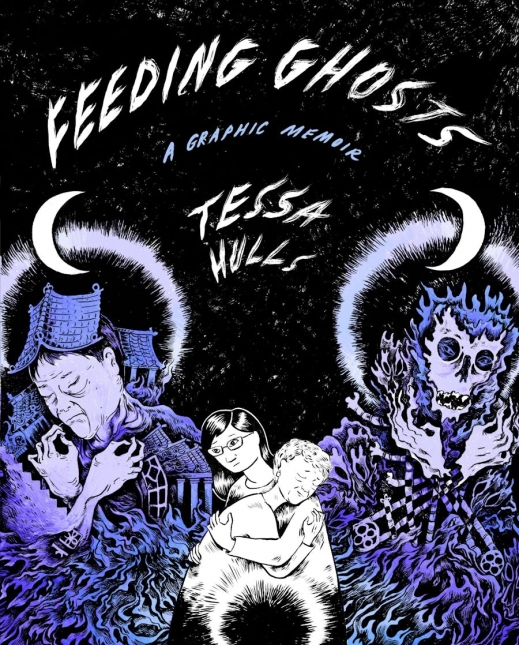Feeding Ghosts: A Graphic Memoir
- By Tessa Hulls
- MCD
- 400 pp.
- Reviewed by Samantha Neugebauer
- March 29, 2024
Three generations of women navigate life in China and the U.S.

In 1992, Art Spiegelman’s Maus became the first graphic novel to win a Pulitzer Prize. The book, which blended memoir, historical documentation, and humor to tell the story of Spiegelman’s father’s experience in the Holocaust — and his own as a survivor’s son — paved the way for the graphic novel to be taken seriously as a genre.
Since then, the capacious form has attracted numerous artist/writers, especially those wanting to tell stories of intergenerational trauma and personal history entwined with major historical events. In light of that, Tessa Hulls’ poignant new graphic memoir, Feeding Ghosts, while hailed as “genre-defying,” could more appropriately be characterized as joining a rich lineage of similarly multifaceted works.
At its core, Feeding Ghosts is the story of three generations of women in Hulls’ family — her grandmother, Sun Yi; her mother, Rose; and herself — set against the backdrop of the Communist Revolution in China, her family’s migration to America, and Hulls’ journey to China to learn her grandmother’s true history. In another life, Sun Yi was a journalist in Shanghai; she witnessed the Communist takeover of the city and, after several harrowing years, fled to Hong Kong with Rose. Sun Yi also penned a memoir of her own, but by the time Hulls knows her grandmother in Ameria, she is a shell of her former self and suffering from severe mental illness.
Hulls excels at depicting the dynamics of matriarchal relationships. As a child, she observed the sacrifices her mother made to take care of Sun Yi and recognized the tiptoeing both she and her mother did to keep her grandmother calm. In one of the book’s most moving sections, Hulls portrays Sun Yi’s solitary days, which she would spend reading and writing while growing increasingly agitated by her daughter being away at work. Writes Hulls:
“The instant my mother opened the door, Sun Yi would fall upon her with an uncontrollable torrent of fears to be assuaged. This was the daily ritual between mother and daughter. A call-and-response where love looked like rescue: one party sinks into waves of terror, while the other swims for them both, saying, ‘You are safe, you are safe, you are safe.’”
Anytime Hulls places Rose and Sun Yi in the same panel, she plays with where one woman ends and the other begins. For example, their faces will be stacked one upon the other like bodyless Russian dolls, or she’ll deploy exaggerated perspectives to suggest how much space each woman is taking up in the other’s life at a given moment. The most interesting visuals, however, belong to those panels in which Hulls and Sun Yi mirror one another by performing the same functions — such as reporting or writing — across time, space, and languages. Another visual pleasure? When the dialogue balloons switch point-of-view from Hulls’ words to those translated from her grandmother’s memoir.
From beginning to end, an ominous darkness permeates the pages, at times in the background, occasionally as a section separator, and often in the panels or even on the characters themselves. It appears as water, flames, screams, brains, ghost silhouettes, and amniotic fluid — elusive yet ever-present. It’s a highly effective method for showing the various ways in which these women are connected.
One of Virginia Woolf’s many talents was her oft-cited use of white space between passages of text. Offering spatial silence, these blank stretches function like gutters — the gap between panels — in comics, allowing for a pause or transition between scenes, and also giving the reader some room to make sense of what they’ve just encountered.
Unfortunately, Hulls seems to underestimate her readers’ ability to do so. Time and again, she goes to great lengths to explicate what we’ve just experienced in-scene. The most egregious instances occur whenever she intends to convey that Sun Yi — by exercising agency or displaying morally ambiguous behavior — is not the pure victim of history that Hulls has previously understood her to be. Rather than trusting readers to keep up, she belabors the point.
Like P. Ôtié and Li Kunwu’s A Chinese Life, Feeding Ghosts can also serve as a primer on the Chinese Revolution. Hulls doesn’t spare us the details of the death, destruction, and intimidation that arose during that time. But there’s one illustration depicting that period which most lingers: that of a smug cadre waiting for Sun Yi to get home from the hospital with her baby daughter, made all the more disturbing by the soldiers’ casually crossed legs. Hulls writes:
“In her book, Sun Yi paints herself as a plucky young mother standing up to harassment [from the men], but who knows what she really said.”
No one, not even Hulls after all her research and travel, can ever know for sure. Sun Yi alone possesses the truth. Still, by understanding what Sun Yi wanted Hulls to think, we come to know her, too.
Samantha Neugebauer is a lecturer at NYU in DC and a senior editor for Painted Bride Quarterly.

